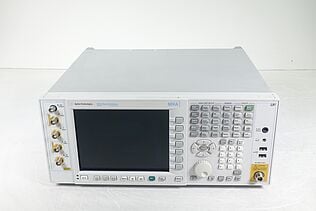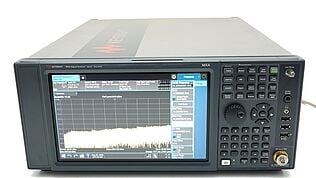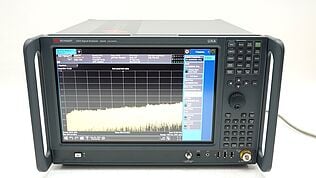- Introduction
- Buy Spectrum Analyzers at a Great Discount
- What is Spectrum Analysis?
- Why is Spectrum Analysis Essential?
- Tools for Spectrum Analysis
- Spectrum Analyzers
- Oscilloscopes
- Signal Generators
- Software Tools
- Spectrum Analysis Techniques
- Steps of Spectrum Analysis
- Applications of Spectrum Analysis
- Telecommunications
- Broadcasting
- Astronomy and Space Research
- Conclusion
- Whenever You’re Ready, Here Are 5 Ways We Can Help You
Have you ever stood on a bustling city street and just listened to the rhythm of life around you? Cars honking, people chatting, music playing, and the wind rustling the trees. For an electrical engineer, spectrum analysis is akin to tuning into that rhythm, but on a different plane – the plane of electronic signals.
Like an orchestra conductor discerning each instrument's role in a symphony, spectrum analysis allows us to separate complex signals into their individual frequencies. This practice is a cornerstone in the field of electrical engineering, where it plays a pivotal role in communication systems and signal processing. At its heart, spectrum analysis is the process of decomposing a complex signal into its basic frequency components.
Buy Spectrum Analyzers at a Great Discount
What is Spectrum Analysis?
Spectrum analysis, also known as spectral analysis, refers to the process used in analyzing the spectral composition of a signal. In simple terms, it breaks down a signal into its individual frequencies. These frequencies are typically plotted on a graph known as a spectrum.
Why is Spectrum Analysis Essential?
- Identifying signal interference: In wireless communication, spectrum analysis helps identify and mitigate interference from other signals.
- Quality assessment: For audio and video broadcasts, it provides quality assessment by identifying distortions or noise.
- Fault detection: Spectrum analysis can be used in fault detection in machinery by identifying changes in the vibration spectrum.
| Key Takeaway |
|---|
| Spectrum analysis helps electrical engineers understand complex signals by breaking them down into frequencies. This helps them analyze system performance and improve electronic and communication systems. |

Tools for Spectrum Analysis
In the realm of signal analysis, a variety of powerful tools and equipment are at an engineer's disposal. These tools help to observe, measure, and analyze the frequency spectrum, ensuring the integrity of signal transmission and the functionality of different systems. Some of the key tools used for spectrum analysis include:
Spectrum Analyzers
A spectrum analyzer is arguably the most direct tool for performing spectrum analysis. This device measures the magnitude of an input signal versus frequency within the full frequency range of the instrument. Essentially, it visualizes different signal components in their respective frequencies.
There are different types of spectrum analyzers, such as:
- Swept-tuned Spectrum Analyzer: It sweeps the frequency range of interest and measures the power level at various points. It's a traditional tool widely used for various applications from RF design to service and maintenance.
- Real-time Spectrum Analyzer: It captures the RF environment, calculates FFTs, and constructs the spectrum in real-time. It's excellent for analyzing signals that vary dynamically in amplitude or are sporadic in nature.
- Vector Signal Analyzer: It's a high-end tool that does not just capture the power and frequency but also the phase information. It's used in sophisticated applications such as designing and testing radar and wireless communication
Oscilloscopes
Digital oscilloscopes now have FFT capabilities for basic spectrum analysis, even though they are primarily used for time-domain analysis.While not as sophisticated or specialized as spectrum analyzers, oscilloscopes are versatile tools that can give valuable insight into the frequency components of a signal.

Signal Generators
Signal generators, while not directly involved in analyzing the spectrum, play a crucial role in the process. They produce signals with known characteristics, which can be used as a baseline to compare with the signal under analysis. For instance, a signal generator can produce a pure tone of a known frequency, which can then be introduced to a system. The output can be analyzed with a spectrum analyzer, and any differences from the original signal can indicate system performance or flaws.
Software Tools
In addition to the physical hardware, software plays an ever-increasing role in spectrum analysis. Software solutions can provide a flexible and cost-effective platform for conducting sophisticated signal analysis. These tools can perform complex computations, visualize data in user-friendly formats, and automate testing processes. Examples include MATLAB, LabVIEW, and Python libraries like SciPy and NumPy, which have built-in functions for Fourier Transform and other spectral analysis techniques.
Spectrum Analysis Techniques
A range of techniques exist for performing spectrum analysis. Some of the most common include:
- Fourier Transform: A mathematical method that transforms a function of time, a signal, into a function of frequency.
- Short-Time Fourier Transform (STFT): Analyzes a small section of the signal at a time and provides a compromise between time and frequency information.
- Wavelet Transform: This method provides high-resolution frequency information with low-resolution time information and vice versa.
| Technique | Pros | Cons |
| Fourier Transform | Complete frequency representation | No time information |
| STFT | Provides time and frequency information | Limited resolution |
| Wavelet Transform | Adjusts time and frequency resolution | Complex implementation |
Steps of Spectrum Analysis
Spectrum analysis is not a one-and-done affair; rather, it involves a careful and systematic process to ensure precise and useful results. Here are the typical steps involved in performing a spectrum analysis:
- Capture the Signal: The first step involves capturing the signal you wish to analyze. This requires an oscilloscope, signal analyzer, or similar device. It's important to ensure the accuracy of your capture settings, including your sample rate and the duration of capture. Remember that according to Nyquist's theorem, the sample rate should be at least twice the maximum frequency component of the signal to avoid aliasing.
Choose the Analysis Technique: Next, you must decide which spectral analysis technique to apply. The Fourier Transform is a common choice, as it can break down a signal into its constituent frequencies. However, other techniques like Short-Time Fourier Transform (STFT) and Wavelet Transform might be more appropriate for signals where frequency components change over time.
Apply Window Function: Window functions are mathematical functions applied to the captured signal to reduce spectral leakage. Spectral leakage happens when the signal is not exactly periodic within the sample window, leading to a "smearing" of energy across the frequency spectrum. Common window functions include the Hamming window, Hann window, and Blackman window. The choice of window function depends on the trade-off between spectral resolution and leakage that you're willing to accept.
Perform the Transform: The chosen transform is then applied to the captured and windowed signal to convert it from the time domain to the frequency domain. This transformation reveals the constituent frequencies of the signal, their amplitudes, and sometimes their phase relationship, depending on the type of transform used.
Interpret the Results: The final step involves interpreting the results. This could mean identifying significant peaks in the frequency domain, relating them back to the source components, or analyzing harmonic relationships. It might also involve looking for unexpected frequencies that could indicate problems like interference or system instability.
Applications of Spectrum Analysis
Spectrum analysis, with its powerful ability to dissect complex signals, finds immense applications in numerous fields. By providing a window into the frequency domain, it allows engineers and scientists to solve problems, optimize systems, and even discover new phenomena. Here are some key areas where spectrum analysis is utilized:
Telecommunications
In the telecommunications industry, spectrum analysis is vital for designing, testing, and troubleshooting communication systems. It allows engineers to examine signal quality, measure bandwidth, identify sources of interference, and evaluate system performance under different conditions. In wireless communications, spectrum analysis helps ensure efficient use of the frequency spectrum, which is a limited and valuable resource.
Broadcasting
Spectrum analyzers are essential tools for broadcasting applications, including television and radio. They are used to set up and maintain transmitters, ensuring that signals are broadcast within their assigned frequency bands and do not interfere with each other. In digital broadcasting, spectrum analysis can help verify compliance with standards like DVB (Digital Video Broadcasting) and ATSC (Advanced Television Systems Committee).
Astronomy and Space Research
In the realm of astronomy and space research, spectrum analysis plays a crucial role in studying celestial bodies and cosmic phenomena. By analyzing the spectrum of signals received from space, scientists can determine the composition of stars and detect distant galaxies. In satellite communications, spectrum analysis helps to monitor signal quality, troubleshoot issues, and maintain reliable communication links.
These examples underscore the importance and versatility of spectrum analysis. By breaking down signals into their frequency components, it provides valuable insights that aid in everything from the design and optimization of communication systems to the exploration of the cosmos.
Conclusion
Spectrum analysis stands as a fundamental pillar in the world of electrical engineering and beyond. By converting the invisible dance of signals into a visual, comprehensible format, it allows you to delve into the heart of complex systems, uncover issues, optimize performance, and create robust and efficient electronic and communication systems. It is, indeed, an art – an art that's evolving with the advent of new technologies and algorithms, becoming more sophisticated, more precise, and increasingly indispensable.
If you're ready to take your engineering projects to the next level, or simply need to upgrade your current setup, consider visiting Keysight's Used Equipment Store. Their comprehensive range of pre-owned, refurbished equipment includes a wide array of spectrum analyzers, oscilloscopes, and more, providing the best in quality used equipment. Embrace the art and science of spectrum analysis with Keysight, and make your mark on the symphony of signals.

Browse Spectrum Analyzers at a Great Discount
Select up to 3 instruments to compare
Enable Notifications
In order to use this feature, you need to enable notifications.
Manage notification preferences
Whenever You’re Ready, Here Are 5 Ways We Can Help You
- Browse our Premium Used Oscilloscopes.
- Call tech support US: +1 800 829-4444
Press #, then 2. Hours: 7 am – 5 pm MT, Mon– Fri - Talk to our sales support team by clicking the icon (bottom right corner) on every offer page
- Create an account to get price alerts and access to exclusive waitlists.
- Talk to your account manager about your specific needs.
























































